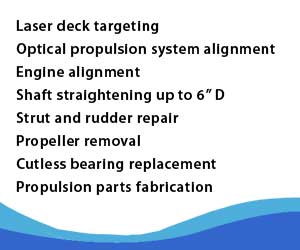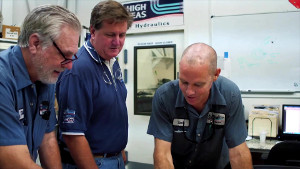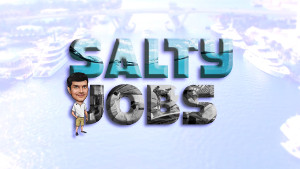Strut Alignments
A properly aligned strut is a critical component to an overall smooth running propulsion system. All too often yards and mechanics will straighten shafts or align engines without looking at the strut bearing alignment. Struts can be out of alignment due to a poor factory set-up or a hard grounding causing a bent or twisted strut.
This article covers the alignment of a strut with a fixed cutlass bearing. That is – the cutlass bearing is pressed into the strut barrel without any play or ability to adjust. There is another process used on some boats that allows a cutlass bearing to be “float aligned” – the boar of the strut barrel is much larger that the outer diameter of the cutlass bearing and filler material is used to aim the bearing without moving the strut. This process is discussed in detail in the next technical article titled Cutlass Bearing Float Alignment. Whether your boat requires a strut alignment or a floated bearing alignment is based on the original construction of the boat. Strut alignments are complex and require the proper alignment systems. Once a strut is removed from a boat it is a major repair and should only be left to the specialist and professionals in this field.
A strut alignment begins with the alignment analysis. We prefer the exactness of a optical scope alignmentto measure precise misalignment. When scoping the strut from behind a set of optical targets are placed in the aft end of the strut bearing and the forward end. The scope is set up and aligned to the current strut bearing. Once the scope is set to that alignment it is easy to focus forward on the exit tube – if the bearing aimed directly at the center of the exit tube the strut is misaligned.
In order to align the strut it must be removed or dropped from the bottom of the boat. All of the strut bolts are removed and a considerable forced is applied to break the bond between the strut and the hull (typically and epoxy, chalk-fast, marine tex or 5200). Proper equipment and safety are a major concern since some struts can weigh hundreds of pounds each.
Once removed, the strut pad and hull pocket must be ground clean in preparation for installation. Extra jacking holes are drilled and tapped in the four corners of the strut pad to help with fine tuning adjustments. Once preparation is complete, the strut is put back into position by hanging it in place with all thread, nuts and washers in four of the original strut bolt holes. The optical scope is reset and the optics are placed back in the strut cutlass bearing. Using a variety of jack bolts and adjustment screws the strut is slowly put into the right alignment position.
When the strut is in the proper aligned position there will be a gap between the hull and strut. ChockFast or Marine Tex is injected in this gap to form a perfect fit with the bottom of the hull. The strut bolts are drilled out to remove the filler material and the bolts are put back in place with 5200.
Aligning a strut is usually a once in a boat-life project unless a catastrophic grounding occurs. A properly aligned strut will free-up an engine to provide a smooth ride for comfort and higher speed, lower fuel consumption for performance. Driving around with a poorly aligned strut is like driving your car with the parking brake on – you are just using horsepower to overcome unnecessary friction.


 Click to watch the video of a day at High Seas Yacht Service.
Click to watch the video of a day at High Seas Yacht Service. Click to watch Marine Industries Association of South Florida video featuring Salty Jobs at High Seas Services.
Click to watch Marine Industries Association of South Florida video featuring Salty Jobs at High Seas Services.